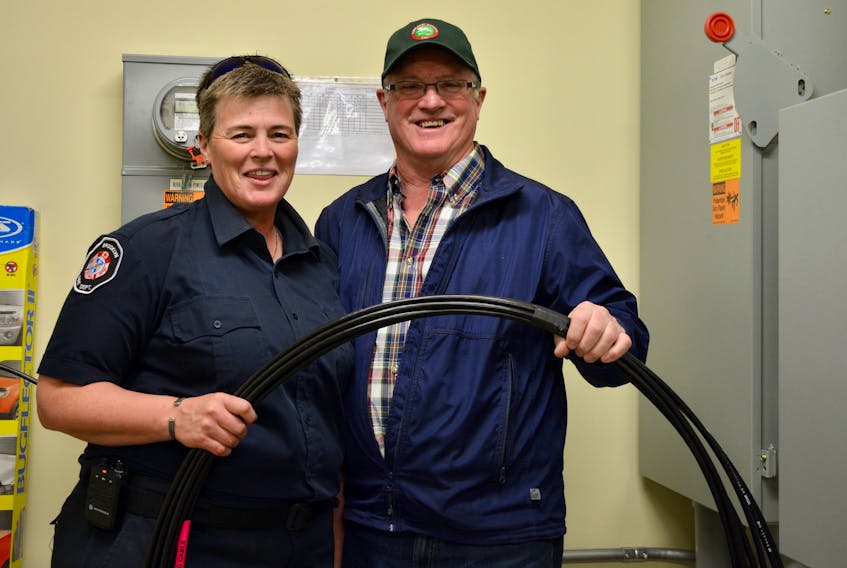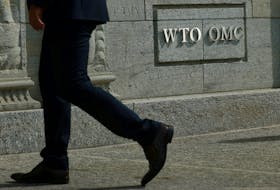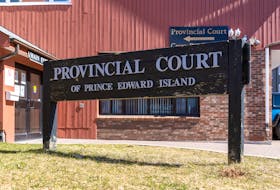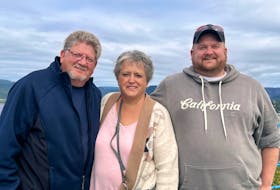“It’s a series of tubes.”
That’s how former United States Senator Ted Stevens, a republican from Alaska, famously described the internet in 2006.
The simplistic and oft-derided explanation has been mocked and ‘memed’ online ever since those words were uttered. However, in Brooklyn, Nova Scotia, a series of tubes is exactly what’s being installed in order to increase internet speeds in that community.
The extended fibre network is nearing completion, as cables are being installed from the Windsor area into the community of Brooklyn, thanks in part to a $75,000 grant from the province and approximately $150,000 in gas tax funding.
It’s something that members of that community are anxiously awaiting. The upgrade will potentially boost their maximum internet speeds to upwards of 50 or 70 megabytes per second, where they’re lucky if they hit 10 megabytes per second now.
These are speeds people in more urban areas, like Halifax, take for granted. But in some communities across Hants County, residents are stuck in the dial-up past.
The increase in speed will make it easier for Brooklyn residents to connect to friends and family online, access digital entertainment, like Netflix and online gaming, and also operate websites for their own businesses.
West Hants Coun. David Keith has been pushing for high speed internet since the 2016 election. He says residents are begging for it.
“When we started campaigning, I was shocked as we got into Ashdale, Hillsvale, and I was knocking on people’s doors… within the first couple of days they’d say ‘David, can you help us?’” Keith said. “They told me ‘we cannot sell our homes.’ What used to be important was water, and it’s not that anymore. If you don’t have high speed (internet) they’re walking out.”
Keith admits he doesn’t use the internet himself too often. He’s not on social media, doesn’t watch Netflix, but he knows his constituents do — or at least, would like to with much faster speed.
“The more doors I knocked on, the more I heard it,” he said. “Kids go to Avon View, or Brooklyn, and when they come home they can’t do their homework.”
Since the election campaign, Keith said he’s made bringing high speed internet to the rural communities in West Hants one of his top priorities.
He’s not alone in that, the provincial government, federal government and many other municipal governments are realizing how crucial access to high speed internet has become.
First steps
“It’s the great equalizer,” Keith said. “What high speed internet does is allow people who live in rural Canada to compete with the large companies that are on Bay Street or Wall Street. Everyone is on the same level.”
Keith said more people would move to rural areas, like Brooklyn or Ashdale, if they had access to higher speed internet, which would allow them to work from home.
“You have someone, say in Bramber, and they can go on their computer and work for a big company, or the government, or anybody, right from their home,” he said. “A lot of people would love to get out of the cities, but they’ve got a noose around their neck because they have to be able to work from home. They’d love to have a couple acres with some chickens.”
The Brooklyn extension is nearing completion, but Keith said it’s only the first step.
“Brooklyn is the hub. We can’t get the internet to other communities until it’s set up here first,” he said. “Now we’re ready for provincial and federal money to extend this to those other communities. This is only the start of something much bigger.”
Keith said now that Brooklyn’s fibre is almost in place, it’ll make the surrounding communities more attractive when the provincial and federal government start investing in rural internet projects.
But it has been a learning process — crossing rivers, installing poles and cables, not to mention dealing with wildlife.
The Brooklyn Fire Department fibre was almost delayed thanks to a bird’s nest inside the box on one of the telephone poles near the station. Luckily there was already a buried tube leading into the building that they could access, bypassing the birds altogether.
Keith is hoping the high-speed connection will reach the fire station in the coming weeks, once everything gets approved and finalized.
“I am a little surprised this has taken this long, but sometimes good things take time,” he said.
“There are few things more important than this. Without fibre, I don’t think young people are going to stay in our rural areas,” Keith added.
“Does it get any more serious than that? I don’t think so. We’re talking about the survival of our communities.”
Real estate barriers
Angela Mailman, a realtor with ViewPoint Realty based in Windsor, said high speed internet is quickly becoming a major asset for prospective homebuyers.
“We see this every day now. About five years ago it wasn’t as big of a concern for those buyers, but nowadays it’s one of their leading questions,” Mailman said.
“All consumers use the internet, whether it’s just for streaming Netflix or gaming, but now there’s a growing number of people who work from home,” she said.
“If the speed is not fast enough for them, they just can’t move to particular areas.”
Mailman said every community that doesn’t have access to high-speed internet becomes more challenging to sell.
“A part of Falmouth has fibre, another part of Falmouth does not,” she said. “Only three minutes distance from one house to another, but different speeds are available, and that has a bearing on consumers.”

She said she’s hopeful that recent rural internet investment announcements will bear fruit.
“People are looking for these bigger properties that afford them privacy, but with that, it’s often coupled with slower internet speeds,” she said. “And whether people are planning to run a small business out of their home or even just being able to telecommute, they need to have that speed available.”
But it’s not just permanent homes where high-speed internet is becoming a necessity. Mailman says it’s becoming a must for recreational and seasonal properties as well.
“Even with vacation properties or cottages, people still want to be accessible,” she said. “If somebody wants to go away to a cottage for a couple of weeks, they still want to be able to connect without having to drive down the road to get it.”
High speed an ‘essential service’
Martin Laycock, the chief administrative officer for West Hants, admits that he’s a geek. He likes technology, and access to high speed internet is something he couldn’t dream of giving up.
For him, bringing high speed fibre to rural communities is a no-brainer.
“During our strategy sessions we had a number of community meetings and it was brought up all the time,” Laycock said. “’I need the internet, please fix the internet, the internet is too slow.’”
Laycock references an internet speed performance test, where users submit their internet speeds to a heat map. The results were grim for more rural parts of Hants County.
Cogmagun had an average download speed of 1.13 megabytes per second. Mill Section 1.22. Kempt Shore a devastating 0.75. Scrolling around the region highlights how low the average speed can be.
Laycock’s own threshold, which he personally sees as the minimum, is the ability to stream Netflix without issues.

“The average person isn’t uploading and downloading terabytes of data, but they might want to watch Lost In Space on Netflix,” he said.
Laycock said attracting businesses to the area also makes high speed a priority.
“We have the lowest commercial tax rate in the province, and we want to take advantage of that,” he said. “High speed internet is basically an essential service now.”
The CAO admits that the entire process with the Brooklyn project has been a major learning curve for the municipality, dealing with permits and restrictions and complex IT components. However, he said they’ll be able to use that knowledge for future projects, making the Brooklyn extension something of a pilot.
“I had no idea how complicated this process was, but we’re learning,” he said. “Our goal, ideally, is that hopefully we’ll get some good news with funding announcements from the province and the federal government.”
Still, building the fibre network is only step one. Step two is ensuring there’s a business that can actually provide the service to potential customers.
“There’s nothing stopping us from doing that ourselves, but ideally we’d be selling it through local companies,” he said. “We will be able to provide internet to the Brooklyn fire station because we can just basically take our internet connection and pump it to their building because we own it.”
Laycock said if everything goes according to plan, he’d like to see high speed internet rolled out to a large portion of the municipality within five years.
“I don’t care how people get the internet; I don’t care if aliens come down and put the internet on polls, as long as people are getting access to the internet,” he said. “It’s 2018. We need it.”
A provincial priority
Following a recalculation of provincial royalties from offshore oil revenues, the provincial government found itself in an enviable position — they had extra money (about $250 million) to spend.
With that sudden influx of cash, the provincial government decided to invest a major portion, approximately $120 million, into improving and expanding rural internet.
Kent Roberts is the managing director of business relations and innovation at the department of business. He’s also the government’s de facto point man for most things internet-related.
“It kind of goes without saying that the internet and access to the world is critical for economic development,” Roberts said. “This strategy is meant to ensure that all areas of the province can participate in the economy, no matter where they live and choose to work.”
How and when that gets rolled out is still being determined, but Roberts said it should make a significant impact.
“We will reach 95 per cent of Nova Scotians… of 50 megabytes download speed, 10 megabytes upload for wired service and 10 megabytes downtown and two megabytes upload for wireless service,” he said. “That’s the minimum standard that we’re shooting for.”
Roberts said a recent report outlined a five-year timeline to achieve those infrastructure standards across the province.
In order to reach those lofty targets, it’s estimated to cost between $300 and $500 million. But the province is hoping to partner with municipalities, the federal government and internet service providers to get there.
“This has become a key infrastructure question right across the country,” he said. “High-speed internet has gone from a ‘nice-to-have’ to almost a key piece of infrastructure like a road connecting communities."
Did you know?
Why is fibre so much faster than conventional copper connections? Fibre cable is constructed out of glass, with information travelling via pulses of light. And nothing in the known universe travels faster-than-light, meaning the information can be uploaded and downloaded extremely fast. It also maintains a much higher bandwidth than traditional copper cables, meaning more information travels at a faster speed.









